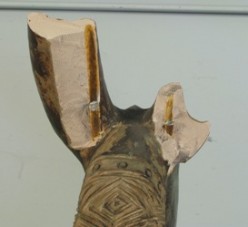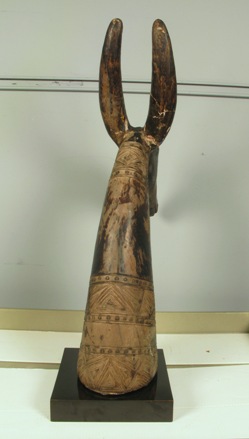By Natalia Ivancevich, Assistant Conservator of Objects; and Gabrielle Tieu, Senior Conservator of Objects
(Above) Pre-treatment: African antelope sculpture
A two foot tall plaster replica of a traditional African carved wooden sculpture of sentimental importance came to The Center from a private collection after it had incurred severe damage from a fall. The impact of the fall bent the steel armature within both of the ears and caused them to shatter into over one hundred pieces. After careful examination of the piece, we decided the bends were irreversible due to the damage that rebending the metal might cause to the intact sections of the sculpture. Despite this, we determined it was possible to reassemble the broken ears and restore them to their original appearance.
(Above) Pre-treatment: Antelope with broken elements
(Above) Detail of broken elements
In the first stage of treatment, we cut out the bent sections of the armature to allow the broken plaster fragments to fit back in place. We then drilled holes in the severed ends of the steel and inserted new brass rods into the holes to act as replacements.
(Above) During treatment: After cutting steel armatures
Once drilling was complete, we began systematically re-adhering the fragments in sections using an acrylic resin. This process was extremely challenging because of the number of fragments and the variety of their shapes and sizes; it required us to pay great attention to detail so as not to prematurely re-adhere two pieces, locking out other fragments. Many of the plaster fragments were missing,,so once the retained fragments were assembled we filled the remaining losses with a reversible gypsum-based filler. We then inpainted the fills with acrylic paint to emulate the surrounding areas.
(Above) During treatment: Reassembly of broken elements
The treatment was a success: the ears are now structurally stable and aesthetically are very convincing. We were also able to preserve the retained original materials.
(Above) After treatment (back view, side and front)
Heavy artifacts composed of fragile protruding parts well exemplified by this antelope head sculpture are especially vulnerable to falls. Thus it is important to consider alternative mounting and display options such as a vitrine, secured pedestal, or sturdy mount plates to ensure the safety of the work for its future.











